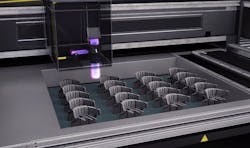Ceramic 3DP Expands the Possibilities for Investment Casting
There was a moment in the recent past when analysts and investors worried that investment casting would be displaced by alternative production methods that are less process-intensive, less time-consuming, less expensive. The argument was that additive manufacturing (AM) technologies were a more economical route from design to production.
But the value of investment casting is directly related to the value of the parts resulting from the process — precision castings, often in specialty alloys, and designed and manufactured as investment castings because the process ensures the most reliable structural and material results. More to the point, investment casting has become a significant market for AM technologies: AM has proven to be an effective and increasingly standard way to produce wax patterns that are essential to investment casting. Because the process is able to achieve such precision, it invites designers to introduce lighter and more efficient design possibilities for standard cast products.
Signicast, one of the most recognizable investment casting businesses, also has used additive processes to expand its prototyping services. Now, it has established a partnership with an AM technology developer to offer 3D-printed ceramic prototypes
The technology for this is Large Area Maskless Photopolymerization (LAMP), developed by Signicast's new partner DDM Systems.
DDM is also a manufacturer of investment castings, produced using 3D-printed ceramic shell molds.
The LAMP technology uses a ceramic resin that is cured with UV light to produce cores and molds, in a method that has been described as a hybrid of stereolithography and sand or powder-based 3D printing.
The process starts in a way similar to sand or powder 3D printing, with a ceramic resin material on a build platform in place of sand (or powder.) Rather than a binder agent marking out the successive layers of the finished object, the "printer head" projects an ultra-violet light onto the resin, causing it to solidify.
The ceramic structures that result can achieve the high level of detail expected of investment casting cores and molds.
The process was invented by the Georgia Tech Direct Digital Manufacturing Lab, with funding by the Dept. of Defense and DARPA’s Disruptive Manufacturing Technology project. Developer Suman Das licensed the technology and established DDM Systems with John Halloran in 2012 to commercialize the technology for manufacturing.
The LAMP machine has an adjustable build platform that can be configured at 10ix10x12 in. for small-lot rapid prototyping, or up to 24x24x24 in. for production scale.
Signicast noted that LAMP technology introduces important capabilities in the production of increasingly complex designs — including topology optimization and generative designs — and it does this with the convenience and lead times that first made AM/3DP so compelling.
The new prototypes will add to the portfolio Signicast already offers, encouraging the design freedom that has been the strength of investment casting all along. Topology optimization and generative design will mean designers can reduce the weight of finished products, and propose "more organic, complex geometries" that would be difficult or impossible to produce by conventional techniques.
Designs with more ergonomic features, and with lower material cost and shorter lead-times, are other anticipated features.
"This is a great process to bring to Signicast customers and offers new growth opportunities to all the markets we serve," Marc Riquelme, Signicast president stated. "DDM's 3D-printing technology will bolster our core offering and amplify our footprint in additive manufacturing."
